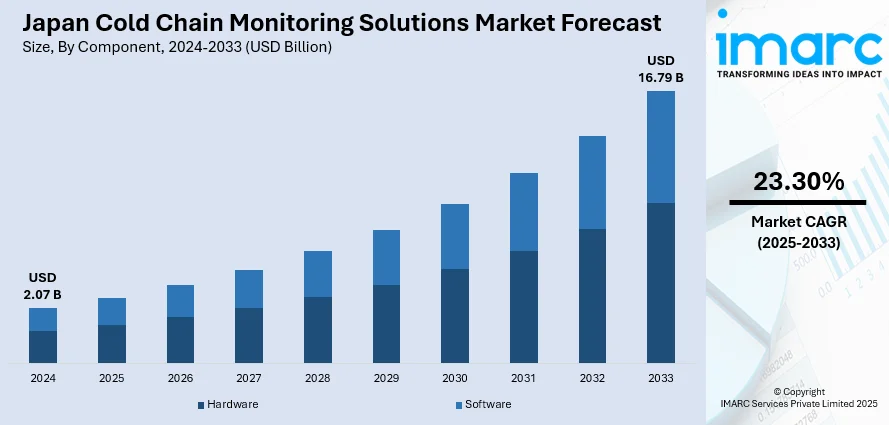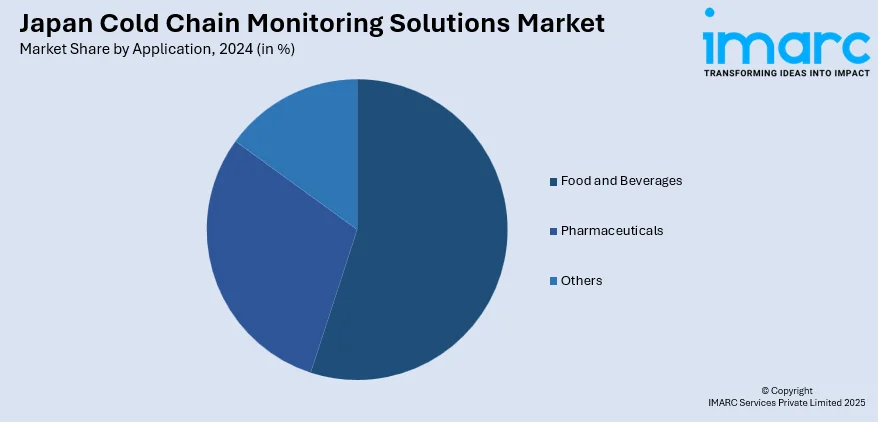
Japan Cold Chain Monitoring Solutions Market Size, Share, Trends and Forecast by Component, Application, and Region, 2025-2033
Japan Cold Chain Monitoring Solutions Market Overview:
The Japan cold chain monitoring solutions market size reached USD 2.07 Billion in 2024. Looking forward, IMARC Group expects the market to reach USD 16.79 Billion by 2033, exhibiting a growth rate (CAGR) of 23.30% during 2025-2033. The market is seeing high growth on account of regulatory standards, technological innovation, and high demand for temperature-sensitive products. These factors in tandem contribute to the growth of the Japan cold chain monitoring solutions market share.
|
Report Attribute
|
Key Statistics
|
|---|---|
|
Base Year
|
2024 |
|
Forecast Years
|
2025-2033
|
|
Historical Years
|
2019-2024
|
| Market Size in 2024 | USD 2.07 Billion |
| Market Forecast in 2033 | USD 16.79 Billion |
| Market Growth Rate 2025-2033 | 23.30% |
Japan Cold Chain Monitoring Solutions Market Trends:
Stringent Regulatory Compliance
Japan's cold chain monitoring solutions market is driven considerably by the nation's strict regulatory requirements for the storage and transportation of perishable commodities, especially pharmaceuticals and foodstuffs. The Pharmaceutical and Medical Device Act (PMD Act) and the Food Sanitation Act require stringent temperature control in order to ensure product safety and integrity. These regulations force companies to implement sophisticated cold chain monitoring systems to maintain compliance and avert fines. Therefore, the market has seen increased demand for accurate and reliable monitoring solutions, which has spurred growth. Organizations are now investing more in those technologies that provide real-time temperature monitoring and data logging to enable them to comply with these regulations effectively. This reflects the pivotal importance of compliance in defining the cold chain monitoring environment in Japan. For instance, in March 2025, Japan promoted its cold chain logistics standards across Asia following their adoption by the International Organization for Standardization (ISO). These standards, rooted in Japan’s domestic practices, regulate the entire cold supply chain, from production to retail. The move is aimed at boosting Japanese shipping companies and food exporters amid rising demand for refrigerated transport in countries like Indonesia and Thailand. The strategic push offers Japan a competitive edge as Asia’s cold chain market continues to expand.

Technological Advancements in Monitoring Systems
The integration of advanced technologies such as the Internet of Things (IoT), Artificial Intelligence (AI), and blockchain are propelling the Japan cold chain monitoring solutions market growth. IoT-enabled sensors deliver real-time temperature and humidity information, increasing transparency across the supply chain. AI-based algorithms scan this information to forecast possible disruptions and streamline routes, thus increasing efficiency and minimizing spoilage. Blockchain technology guarantees transparency and traceability, enabling stakeholders to confirm the conditions under which the products were shipped. For instance, in April 2025, Cold Chain Technologies introduced the CCT Tower Elite, a reusable 1600L pallet shipper equipped with multi-temperature control and IoT-enabled tracking. This innovation strengthened the secure transport of temperature-sensitive goods in Japan, enhancing delivery precision and contributing to the advancement of the country's cold chain logistics infrastructure. As a result, businesses are increasingly adopting such technologies, contributing to the market's expansion.
Japan Cold Chain Monitoring Solutions Market Segmentation:
IMARC Group provides an analysis of the key trends in each segment of the market, along with forecasts at the country/regional levels for 2025-2033. Our report has categorized the market based on component and application.
Component Insights:
- Hardware
- Sensors
- RFID Devices
- Telematics
- Networking Devices
- Others
- Software
- On-premises
- Cloud-based
The report has provided a detailed breakup and analysis of the market based on the component. This includes hardware (sensors, RFID devices, telematics, networking devices, and others) and software (on-premises and cloud-based).
Application Insights:

- Food and Beverages
- Fruits and Vegetables
- Fruit Pulp and Concentrates
- Dairy Products
- Milk
- Butter
- Cheese
- Ice Cream
- Others
- Fish, Meat, and Seafood
- Processed Food
- Bakery and Confectionary
- Others
- Pharmaceuticals
- Vaccines
- Blood Banking
- Others
- Others
A detailed breakup and analysis of the market based on the application have also been provided in the report. This includes food and beverages [fruits and vegetables, fruit pulp and concentrates, dairy products (milk, butter, cheese, ice cream, and others), fish, meat, and seafood, processed food, bakery and confectionary, and others], pharmaceuticals (vaccines, blood banking, and others), and others.
Regional Insights:
- Kanto Region
- Kansai/Kinki Region
- Central/ Chubu Region
- Kyushu-Okinawa Region
- Tohoku Region
- Chugoku Region
- Hokkaido Region
- Shikoku Region
The report has also provided a comprehensive analysis of all the major regional markets, which include Kanto Region, Kansai/Kinki Region, Central/ Chubu Region, Kyushu-Okinawa Region, Tohoku Region, Chugoku Region, Hokkaido Region, and Shikoku Region.
Competitive Landscape:
The market research report has also provided a comprehensive analysis of the competitive landscape. Competitive analysis such as market structure, key player positioning, top winning strategies, competitive dashboard, and company evaluation quadrant has been covered in the report. Also, detailed profiles of all major companies have been provided.
Japan Cold Chain Monitoring Solutions Market News:
- In June 2024, Fosun Hive and Idera established a joint venture in Osaka, supported by a JPY 15 billion investment, to build a state-of-the-art cold storage facility. Incorporating natural CO₂ refrigerants and energy-efficient technologies, the initiative supports Japan’s national climate objectives while ensuring high-precision preservation of agricultural products.
- In June 2024, CONCOR partnered with Japan’s ITE to implement eco-friendly cold chain logistics using patented Ice Battery technology. This passive cooling system eliminates the need for diesel generators, maintains ideal conditions for 48–72 hours, and significantly reduces CO₂ emissions.
Japan Cold Chain Monitoring Solutions Market Report Coverage:
| Report Features | Details |
|---|---|
| Base Year of the Analysis | 2024 |
| Historical Period | 2019-2024 |
| Forecast Period | 2025-2033 |
| Units | Billion USD |
| Scope of the Report |
Exploration of Historical Trends and Market Outlook, Industry Catalysts and Challenges, Segment-Wise Historical and Future Market Assessment:
|
| Components Covered |
|
| Applications Covered |
|
| Regions Covered | Kanto Region, Kansai/Kinki Region, Central/Chubu Region, Kyushu-Okinawa Region, Tohoku Region, Chugoku Region, Hokkaido Region, Shikoku Region |
| Customization Scope | 10% Free Customization |
| Post-Sale Analyst Support | 10-12 Weeks |
| Delivery Format | PDF and Excel through Email (We can also provide the editable version of the report in PPT/Word format on special request) |
Key Questions Answered in This Report:
- How has the Japan cold chain monitoring solutions market performed so far and how will it perform in the coming years?
- What is the breakup of the Japan cold chain monitoring solutions market on the basis of component?
- What is the breakup of the Japan cold chain monitoring solutions market on the basis of application?
- What is the breakup of the Japan cold chain monitoring solutions market on the basis of region?
- What are the various stages in the value chain of the Japan cold chain monitoring solutions market?
- What are the key driving factors and challenges in the Japan cold chain monitoring solutions market?
- What is the structure of the Japan cold chain monitoring solutions market and who are the key players?
- What is the degree of competition in the Japan cold chain monitoring solutions market?
Key Benefits for Stakeholders:
- IMARC’s industry report offers a comprehensive quantitative analysis of various market segments, historical and current market trends, market forecasts, and dynamics of the Japan cold chain monitoring solutions market from 2019-2033.
- The research report provides the latest information on the market drivers, challenges, and opportunities in the Japan cold chain monitoring solutions market.
- Porter's five forces analysis assist stakeholders in assessing the impact of new entrants, competitive rivalry, supplier power, buyer power, and the threat of substitution. It helps stakeholders to analyze the level of competition within the Japan cold chain monitoring solutions industry and its attractiveness.
- Competitive landscape allows stakeholders to understand their competitive environment and provides an insight into the current positions of key players in the market.
Need more help?
- Speak to our experienced analysts for insights on the current market scenarios.
- Include additional segments and countries to customize the report as per your requirement.
- Gain an unparalleled competitive advantage in your domain by understanding how to utilize the report and positively impacting your operations and revenue.
- For further assistance, please connect with our analysts.
 Request Customization
Request Customization
 Speak to an Analyst
Speak to an Analyst
 Request Brochure
Request Brochure
 Inquire Before Buying
Inquire Before Buying




.webp)




.webp)












